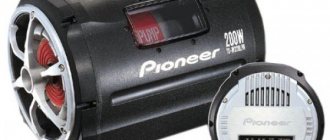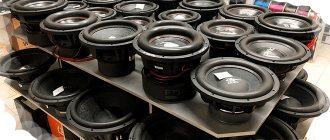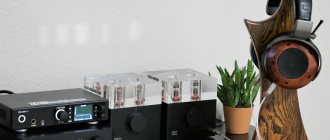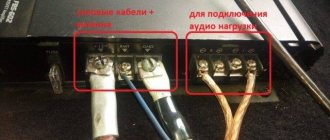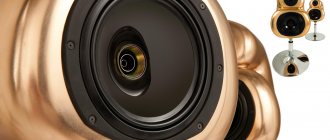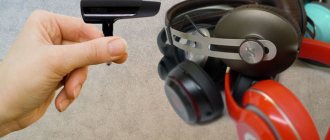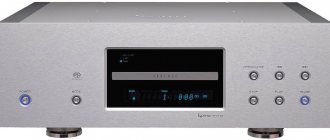I love listening to music. And I love blasting my favorite songs to the whole neighborhood. But really good musical equipment is quite difficult to find. Professional equipment - yes, please: go to a specialized salon, and they will select expensive stage equipment for you. But we only organize rock concerts at home, which means we also need a subwoofer for everyday use. I've probably been looking for a worthwhile device for a month and now I'm ready to tell you what I found out. By the way, now I have an excellent audio system in my apartment, thanks in part to the subwoofer.
| Rating | Name | Characteristics | Price |
| 1 | Ultimate TR100WA Walnut | Best Budget Home Subwoofer | RUB 8,395 |
| 2 | Ultimate SYM5 | Best model with amplifier | RUB 7,590 |
| 3 | Vector HX180 | The best powerful subwoofers | RUB 11,685 |
| 4 | Samsung SWA-W700 | Model with power over 200 W | RUB 12,990 |
| 5 | Canton Sub 8.4 White | The best model with a passive reflector | RUB 36,990 |
Which subwoofer is best for home
There are a huge number of varieties of subwoofers and not all are suitable for a particular apartment or house. In some places, the propagation of sound and frequencies is hampered by space, in others by incorrectly arranged furniture. A specific model can be selected only by taking into account all these factors. The only thing I can do is give some advice on choosing a reliable device for your home.
Choose only high-quality devices. Avoid plastic, especially if you are going to set up a home theater, otherwise the entire system will vibrate. The best solution in this case is to choose a more durable MDF case. But problems can also arise with it in the form of distortion: a closed-type system with powerful sound will cause the walls to rattle. It is best to buy a model that has a heavy wooden body with durable legs.
Pay attention to the price of the subwoofer. Closed-type systems are characterized by an increased cost per watt of power. Such devices have a rich and pleasant sound. Bass reflex models, where the speaker is not protected by anything, do not have proper dynamics. Yes, such a device may have acceptable sound and low cost, but it will not have that sharp volume “bang” that a closed subwoofer can boast of.
Before purchasing, you should decide on the power. If the room is small, then there is no point in purchasing a subwoofer that is too powerful: you will not achieve a positive effect. Sufficient indicator: from 5 to 8 watts per square meter.
An important role when choosing a subwoofer is played by the range of reproduced frequencies. Deep bass is a frequency of 20-40 Hz, mid-bass is 40-80 Hz, high bass is from 80 to 160 Hz. Most subwoofers, despite the statements of the developers, operate in the range from 40 to 200 Hz, that is, they produce mid and high bass. The optimal frequency range for a home subwoofer is 30-60 Hz.
Finally, when buying a subwoofer you should pay attention to:
- realism and depth of sound;
- ease of control;
- available settings;
- and only last but not least – other features and options.
Let's look at some of the most interesting subwoofers on specific models.
Use in stereo
Traditionally, a subwoofer is used as part of a home theater, where it is primarily responsible for sound effects. However, there is quite a successful practice of using a subwoofer in stereo systems. This scheme is called “trifonic” and is designated as 2.1. It has certain advantages over the use of full-size speakers with their own low-frequency path.
Trifonic includes a pair of front speakers and a subwoofer.
The first advantage is quite pragmatic. A subwoofer is most often used together with bookshelf speakers. Since the latter requires less space, and can also sound equally impressive in both large and small areas, the subwoofer will very organically complement the overall sound picture, adding the necessary bass to it. And the owner of the system will not have to rack his brains about where to install large speakers.
The second advantage is not so obvious, although it is directly related to the first. The fact is that the sound of a bookshelf speaker system often has a higher degree of localization compared to floor-standing speakers, so the listener receives a much more voluminous sound panorama. At the same time, one of the most problematic aspects of a home audio system is matching its sound to the listening room and, in particular, correct bass reproduction. And using a subwoofer allows you to get more controllable, deep and clear bass, the sound direction of which is not so clearly localized by the human ear.
Best Budget Home Subwoofers
Ultimate TR100WA Walnut
Bass reflex design. Automatically turns on along with the speaker system. It's easy to achieve the optimal volume balance. There is a built-in amplifier that creates active bass: you can safely use the subwoofer with other sound sources of any power. Supports manual adjustment of the high frequency cut level. A protective screen made of high-strength MDF prevents the appearance of interference on the body elements. Frequency range - from 45 to 180 Hz. The set includes legs and spikes as an additional option. Unfortunately, an uncovered speaker can be easily damaged.
Price: RUB 8,395
Ultimate SYM5
Active type bass reflex with built-in amplifier. The laconic design will fit perfectly into any interior. Made from MDF and vinyl. Built-in amplifier and active subwoofer type. Frequency - 36-150 Hz. Smooth adjustment of phase and HF cutoff frequency. Turns on automatically. Good sound quality for your money. Bass is soft and clear. Unfortunately, the device is quite bulky and can sometimes rattle.
Price: ₽ 7,590
Loudspeaker size
Very often, subwoofers are divided into classes according to the size (usually the diameter) of the working surface of the cone of the installed speaker. The speakers (woofers) used in the construction of subwoofers are, as a rule, the largest in size, because they must move large amounts of air to create low-frequency sound waves. To produce the same volume level at a frequency one octave lower (for example, 30 Hz instead of 60 Hz), you will need four times as much power. The lower the resonant frequency of the speaker, the lower frequency sounds the speaker can reproduce with a given level of distortion. The resonant frequency of a speaker (denoted Fs) is determined by a combination of the mass of its moving parts (cone, protective cap, coil and its base) and the flexibility of the suspension. Under normal conditions, we will need a more powerful amplifier to “drive” the subwoofer speaker than a conventional speaker system. However, it is important to remember that although you should have an amplifier with plenty of power to avoid distortion (clipping), the main task is still to match the subwoofer with the main speaker systems. At any volume level, the subwoofer should not stand out and be localized, but only invisibly expand the sound boundary of the system down the frequency response curve.
The most common speaker sizes for use in subwoofers are 8″, 10″, 12″, 15″ or 18″ (we are talking about the diameter of the round cone). Although an 18″ subwoofer is capable of producing the lowest frequency bass at maximum volume levels, the largest speaker is not always the best choice for optimal reproduction of bass notes. Large woofers are more difficult to control and tune. There are 10″ subwoofers on the market these days that can move as much air as the old 15″ models could. This is made possible by the 10″ speaker's very long-throw cone, designed to maintain linearity throughout its entire travel, and a high-power Class D digital amplifier capable of driving such a woofer in a small cabinet.
The best subwoofers for home with power up to 200 W
Vector HX180
Active subwoofer. Decent power - 185 W and frequency range - from 25 to 180 Hz. Trained to automatically turn on and off. MDF cabinet with vinyl and fabric trim for grille. There is volume and phase adjustment. The bass reflex is directed to the floor, which creates a wide sound flow. The bass is deep and works fine. But you need to tune it solely at your own hearing, peril and risk. After some time, it may begin to make unnecessary sounds and interference. Plastic legs that don't inspire much confidence will most likely need to be strengthened. Quite a decent device in its segment.
Price: RUB 11,685
JBL Sub 250 PBK/230
It boasts a power of 200 W and a frequency range from 32 to 150 Hz. Phase adjustment is stepwise. You can adjust the volume. Automatic switching on. The device is assembled from durable black MDF, using veneer and fabric - the design is interesting and pleasant. Quite a massive device: it weighs 15 kg. Built-in stereo crossover. At medium volume it can wake up half the house. Perfect for an apartment with an approximate area of 40 sq.m. The bass is deep, powerful and clear. It is not for nothing that the manufacturing company is very popular among connoisseurs of high-quality sound. Only the cable included is not very good: sometimes it causes a strong hum when the receiver is turned off. Therefore, it is best to buy a new cord.
Price: RUB 14,390
Bowers & Wilkins CTSW12
pros
- Sound clarity
- Compactness of the device
- High power
- High-quality low-frequency emitter
- Closed design of the device
- Wide frequency range
Minuses
- High price
From 51350 ₽
The subwoofer has a closed cabinet made of durable fiberboard. Internal ties enhance the sound. The device is ideal for installation in a home theater. It's lightweight enough to make it easy to track even the smallest changes in low-frequency signals. The device can be connected to the SA1000 amplifier, which has a power of 1000 W.
The best subwoofers for home with power over 200 W
Samsung SWA-W700
A cute compact subwoofer without any unnecessary design details. Wireless connection. High power - 350 W and frequency range - from 27 to 120 Hz. Acoustic type closed. Turns on automatically. The body is varnished and made of durable black MDF with the addition of vinyl. The subwoofer provides high-quality bass and overall excellent sound. I didn’t notice any significant disadvantages. A really good and stylish device for its purposes. Works great with other speakers. There is a proprietary sound distortion compensation technology that finds potential interference in advance and gets rid of it. Legs included.
Price: RUB 26,990
Canton Sub 8.4 White
The German model is made in white color, already standard: from MDF, fabric and vinyl. Maximum power - 280 W, range - 25-200 Hz. Closed-type acoustic design with a lower passive reflector. The set includes legs. The device weighs about 12 kg. The phase and cutoff frequency, as well as volume, are adjustable. The LED indicator on the front panel indicates the operating mode. A removable network cable is available. To be honest, I didn’t notice any shortcomings. A worthy example of good sound.
Price: RUB 36,990
Installing the system correctly
The format of modern apartments rarely allows one to achieve ideal parameters when installing the system. Meanwhile, the rules for placing speakers in the listening room are extremely important. And even very expensive speaker systems may not provide the same supernatural sound that was in the cabin if they are installed incorrectly at home. The described ten steps when arranging speakers will help both beginner and advanced audiophiles - a number of subtleties can be easily forgotten when trying not to spoil the interior.
Orient the system along the long side of the hall
Mounting along the long wall of the listening room is a real boon for bass line quality and accuracy. As a rule, with such an orientation, the waves simply do not have time to turn around and “start” the room with low-frequency modes. If possible, start the installation with this format.
Move the speakers farther away from the walls
The closer the speaker is placed to the wall, the more bass there will be - but also the less quality it will be. Only a few speaker models (for example, the legendary Klipsch Klipschorn) require installation in the corners of the hall; other models will play perfectly only when they are moved forward 1/3 of the length of the hall! At the same time, if the speakers have large bass reflex ports brought to the rear, they can be safely placed at a distance from the walls of 1/2 the length of the hall - these are the types of complexes you can often see at High End exhibitions. It is difficult to spoil “porridge with butter” in the case of a residential premises.
Orient the tweeter at ear level at the listening point
The height of the seat is also extremely important - if the sofa is very “sunk” (or raised) relative to the height of the speakers, the high frequencies will suffer. You need to choose the optimal height - if this is not possible, go to step 9.
We observe the “golden ratio” - an equilateral triangle
Finally, we are getting closer to choosing a position. The ideal design of the listening area is an equilateral triangle, oriented downwards. The distance from the listener's ears to the speakers and the distance between the speakers should be equal or approximately equal. This point is decisive in building stereo imagery, scene, and maintaining sound coherence.
We turn the speakers so that the listener does not see the side faces of the speakers
Sometimes you can see speakers installed parallel to the side walls of the hall. This is a mistake; according to all canons, acoustic systems should be turned “facing the listener.” The rule for this installation is very simple - sitting at the listening point, the user should not see either the left or right edges of the speakers (this will give a clearer depiction of the scene and create the effect of a real holography of sound images).
We resort to asymmetrical installation in case of bass problems
If the configuration of your furniture, the presence of windows and doors in the hall give bass modes, even if all the conditions described above are met, you can try an asymmetrical installation, turning the line of placement of the acoustic systems towards the corners of the hall. Or even extending and rotating one column. Of course, subject to paragraphs. 2, 3, 5.
Removing the grills
Any grills slightly blur the sound. First of all, the drop in detail is noticeable at high frequencies. If small children or pets do not enter the listening room, it is better to remove the grills from the speakers.
Untying the speakers from the floor
As a rule, floor-standing speakers come with spikes (for bookshelf speakers you will have to buy special stands). It is best to change the decoupling system from the floor, acquiring more massive supports and spikes, so the sound will become more accurate in terms of bass. The overall fidelity of the sound will also improve.
If possible, we use additional anti-vibration platforms
Additional anti-vibration systems will not only help increase the height of the acoustics and ideally orient the height of the tweeter. This will also be an additional strengthening of point 8, having a beneficial effect on the sound quality! If you don’t have the budget for branded plates, a decoupling can be arranged by ordering regular 5 cm aluminum or steel plates to fit the size of the speaker bases. But solutions made from marble can often cause harm.
For cables, you should also think about stands!
The final touch is the cables. Thick wires hanging from speaker terminals can not only vibrate themselves, they also disrupt the stability of the speakers themselves. Especially when it comes to shelf models. Take care of cable holders - if you need to save money, plastic household solutions for wall-mounted storage of packages are perfect. They have many holes and cables laid through such systems will not hang in the air.
Denis Repin October 17, 2022
Comparison table of the best subwoofers
| Name | Main characteristics | Price |
| Ultimate TR100WA Walnut | There is a built-in amplifier that supports manual adjustment of the high-frequency cutoff level, frequency range - from 45 to 180 Hz. | ₽ 8 395 |
| Ultimate SYM5 | Made of MDF and vinyl, frequency - 36-150 Hz. | ₽ 7 590 |
| Vector HX180 | Power - 185 W, frequency range - from 25 to 180 Hz. | ₽ 11 685 |
| JBL Sub 250 PBK/230 | Power - 200 W, frequency range from 32 to 150 Hz, weight - 15 kg. | ₽ 14 390 |
| Samsung SWA-W700 | Power - 350 W, frequency range - from 27 to 120 Hz. | ₽ 26 990 |
| Canton Sub 8.4 White | Power - 280 W, range - 25-200 Hz, weight - 12 kg. | ₽ 36 990 |
FAQ
How powerful should a subwoofer be for a home? Depends, of course, on the area of the room and other factors, but in normal cases somewhere around 150-200 W of power is suitable. It is also necessary to take into account the case material, type of acoustics, etc. But it is best to focus on your taste. You need to turn on and try this or that subwoofer directly in the store.
What is the difference between a car subwoofer and a home subwoofer? As the names suggest: one is designed for a car, the other for home use. They differ in capacity, required volumes of premises, etc. In addition, a car subwoofer, unlike a household subwoofer, is powered by a car generator and battery.
